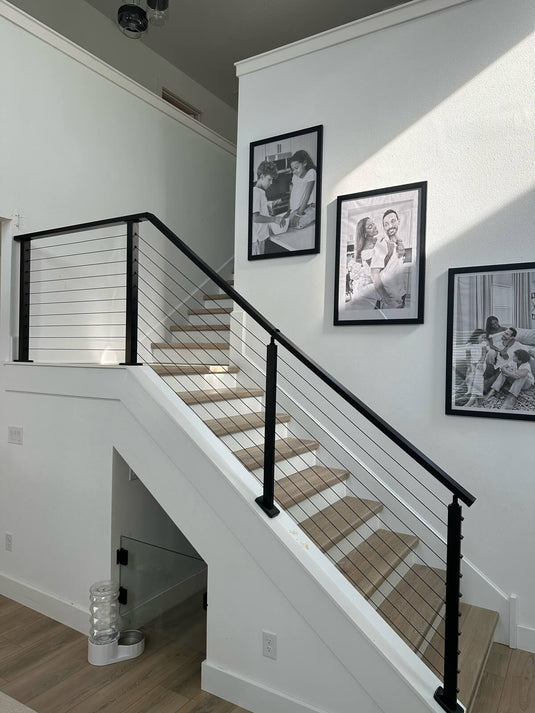TABLE OF CONTENTS
Deck Stair Railing Codes & Safety Guide
Deck railing height is a safety cornerstone—and a common compliance pitfall. Falling short of codes risks fines, injuries, or liability. Most jurisdictions follow the IRC's 36" minimum for decks and 34–38" for stairs, but local amendments or accessibility rules may apply. For DIYers and homeowners, balancing safety, aesthetics, and legality is non-negotiable: improper height weakens structural integrity and devalues your property. Explore how Muzata pre-compliant, weatherproof railings eliminate guesswork—ensuring your deck is secure, stylish, and inspection-ready.

--Photo credit: Ryan Hieb / Muzata customer
🌸🛠️This guide simplifies deck stair railing codes, from federal standards to state variations, so you can merge safety, aesthetics, and compliance. Learn how Muzata code-ready, weather-resistant railing systems save time and stress—letting you focus on enjoying your outdoor oasis. Let's dive in!
Residential Deck Railing Height Requirements
1. General Guidelines in the U.S.
Most U.S. building codes, including the International Residential Code (IRC), require:
● Minimum deck railing height: 36 inches (measured from the deck surface to the top of the rail).
● Guardrails required: If the deck is 30+ inches above ground.
● Stair railing height: Between 34–38 inches (from stair nosing to rail top).
2. Minimum 36-Inch Rule
The 36-inch rule is standard for deck guardrails to prevent falls. Some key points:
● IRC Section R312.1 mandates this height for residential decks.
● Openings (like baluster spacing) must be less than 4 inches to prevent child entrapment.
Muzata Recommendation: Our deck railing kits meet all IRC requirements with durable aluminum and cable railings.
3. Residential Railing Height by State Requirements
While the IRC sets a baseline, some states have stricter rules. Always check local codes!
Residential Railing Height by State (Partial List)
|
State |
Deck Railing Height |
Stair Railing Height |
Notes |
|
California |
42" (if >30" high) |
34-38'' |
Stricter fall protection |
|
Florida |
36'' |
34-38'' |
Hurricane zones may require reinforced rails |
|
Texas |
36'' |
34-38'' |
Follows IRC |
|
New York |
36'' |
34-38'' |
NYC may have additional rules |
🔗 For a full state-by-state breakdown, check ICC's code database.
Stair Railing Height Standards
1. Range: 34-38 Inches
● IRC R311.7.8 requires stair railings to be 34–38 inches high (measured vertically from stair nosing).
● Handrails must be graspable (round or oval shape, 1.25–2" diameter).
Muzata Handrail Solutions offer code-compliant designs in sleek stainless steel and aluminum materials.

Photo credit: Muzata customer
2. Measuring Stair Railing Height
✔ Measure from the stair tread nosing (front edge) upward.
✔ Use a level to ensure vertical accuracy.
✔ For open-riser stairs, measure from the leading edge of each tread.
3. Essential Stair Railing Guidelines
● Baluster spacing: ≤4 inches to ensure child safety.
● Handrail grips: Must be continuous, smooth and uninterrupted with no sharp edges.
● Material durability: Outdoor stairs need weather-resistant railings like powder-coated stainless steel.
● Lighting: Some codes require illuminated stair railings for night safety.

Photo credit: / Muzata customer
Navigating Regional Railing Height Codes (Compliance Across Jurisdictions)
While the IRC provides baseline standards, railing height requirements often vary by region due to:
1. State/Provincial Amendments:
● Coastal states like Florida may enforce stricter wind-resistance rules.
● Earthquake-prone areas (e.g., California) might require reinforced posts.
2. Municipal Zoning Laws:
● Historic districts often mandate specific aesthetics (e.g., wrought iron in Charleston).
● Urban areas may adopt ADA accessibility guidelines for public-facing decks.
3. Climate-Driven Adjustments:
● Northern regions (e.g., Canada) may specify frost-resistant footings.
● Snow-heavy zones might require taller railings for drift protection.

Photo credit: Timber&Outdoor Spaces / Muzata customer
Examples of Regional Differences:
● California (earthquake zones): May require reinforced railings.
● Florida (hurricane areas): Often mandates impact-resistant materials.
Always check with your local residential railing code!
Why Railing Height Matters
1. Importance of Safety
● Proper height prevents falls, especially for kids and elderly. Compliant railing height is critical for safety. According to the CDC, over 3 million elderly adults are hospitalized annually due to falls, with home environments (like decks or stairs) being high-risk areas. Children, due to curiosity and shorter stature, are more prone to falling through gaps or over low rails. A height of 34–38 inches effectively blocks accidental falls by preventing shifts in body balance. For example, a 36-inch railing provides waist-level support for adults, while 4-inch baluster spacing ensures children cannot squeeze through.
● Code compliance avoids fines during inspections. Building inspections are crucial for safety. Non-compliant railings (height, spacing, or structure) can result in fines ranging from 500 to 2,000, plus mandatory repair costs. In regions like California, elevated decks face stricter rules, and violations may trigger stop-work orders. For instance, Florida mandates wind-resistant railings in hurricane zones for final approval. Using Muzata pre-compliant products eliminates costly rework and delays.
2. Liability Considerations
● If someone is injured due to non-compliant railings, you could face lawsuits. Legally, homeowners owe a "duty of care" to visitors. Injuries caused by defects (e.g., insufficient height, loose rails) may lead to negligence lawsuits. In a 2021 Colorado case, a homeowner was ordered to pay $150,000 in medical and emotional damages for non-compliant stair rails. Home insurance may also deny coverage, compounding financial strain. Compliant railings are both a safety measure and a legal safeguard.
3. Aesthetic Impact
● A well-designed railing boosts curb appeal. Muzata offers modern, low-maintenance options. Per the National Association of Realtors (NAR), high-quality outdoor features can increase home value by 7%–12%.

Photo credit: / Muzata customer
Material Choices and Their Pros and Cons
|
Material |
Pros |
Cons |
Best for |
|
Metal (Stainless steel, Aluminum) |
Strong, rust-proof, sleek |
Higher upfront cost |
Modern & coastal homes |
|
Wood |
Classic look, affordable |
High maintenance, rot-prone |
Traditional decks |
|
Composite |
Durable, eco-friendly |
Can fade over time |
Long-term solutions |

Photo credit: twtcustoms / Muzata customer

Photo credit: Adam / Muzata customer
Installation and Preparation Tips for DIY
● Plan Ahead: Measure your deck and stairway and choose a design that complements your home's architecture. Start by measuring the length of your porch where the railing will be installed. Plan the layout, including the number of posts, handrails, fitting and cables needed.
● Gather Tools: Ensure you have a drill, level, and wrench on hand. You'll need a drill, screws, level, measuring tape, and the railing kit from Muzata. Ensure you have all components, including posts, cables, and mounting hardware. Muzata installation package for cable railings typically includes these components, but it's essential to verify the specific products you need based on the manufacturer's instructions.
● Follow Instructions: Muzata detailed guides make installation straightforward, even for beginners.
● Safety First: Wear gloves and safety goggles during installation.
The Buttom Line
Adhering to deck stair railing codes is non-negotiable for safety, legal compliance, and property value. By understanding federal standard and state variationsand, choosing ideal Muzata cable railing for durability and code-readiness--you can ensure a secure, stylish outdoor space that passes inspections and lasts for years.
📌Explore Muzata code-compliant railing system today and transform your outdoor stairs with confidence!
———>>>Muzata Free Design Service
FAQ
What is the standard height of a stair railing?
The standard handrail height is typically between 34 and 38 inches (approximately 86 to 96 cm), measured vertically from the stair nosing to the top of the rail. Regarding the number of steps requiring a handrail, most building codes mandate that a handrail must be installed if there are three or more risers, as this is generally considered a staircase.
At what height is fall protection required?
OSHA requires that fall protection be provided at elevations of four feet in general industry workplaces, five feet in shipyards, six feet in the construction industry and eight feet in longshoring operations.




